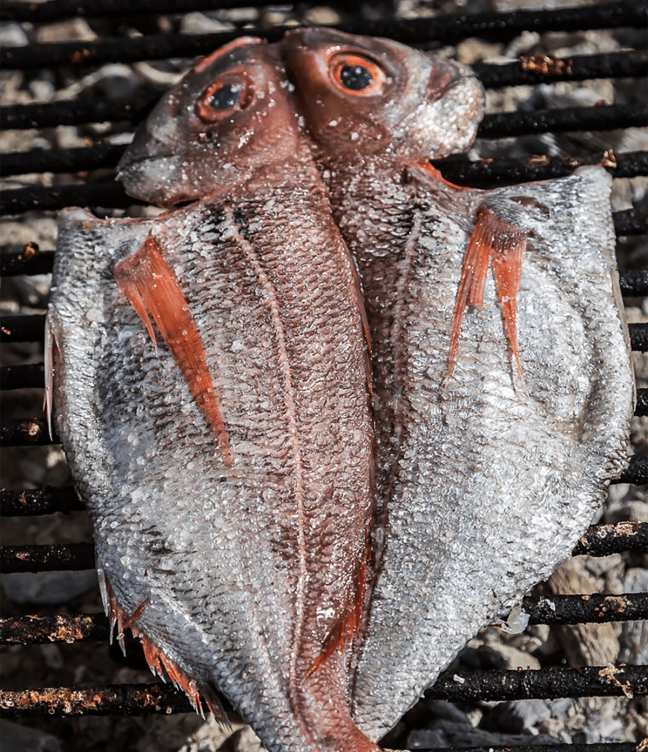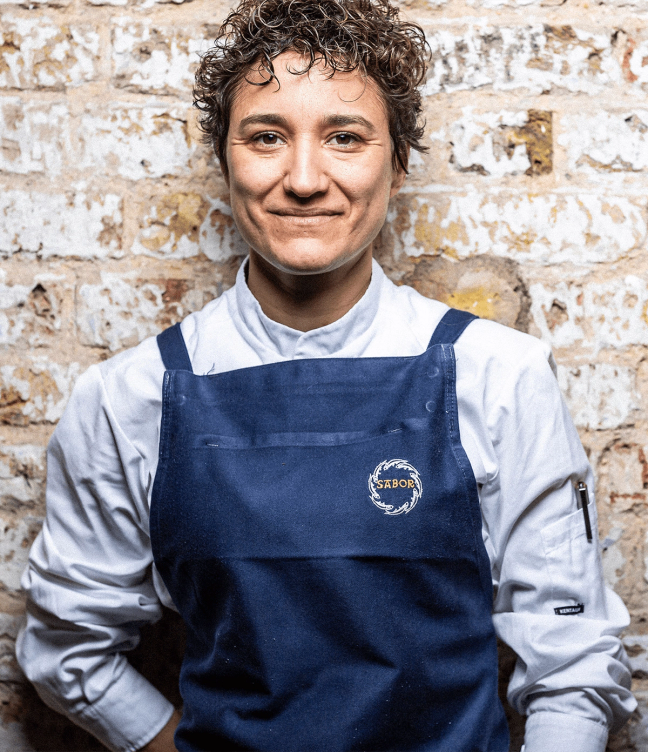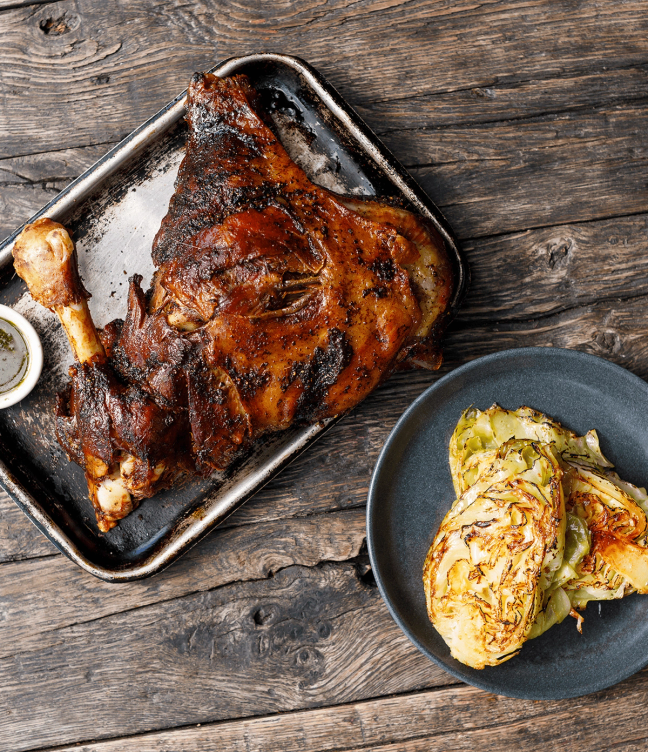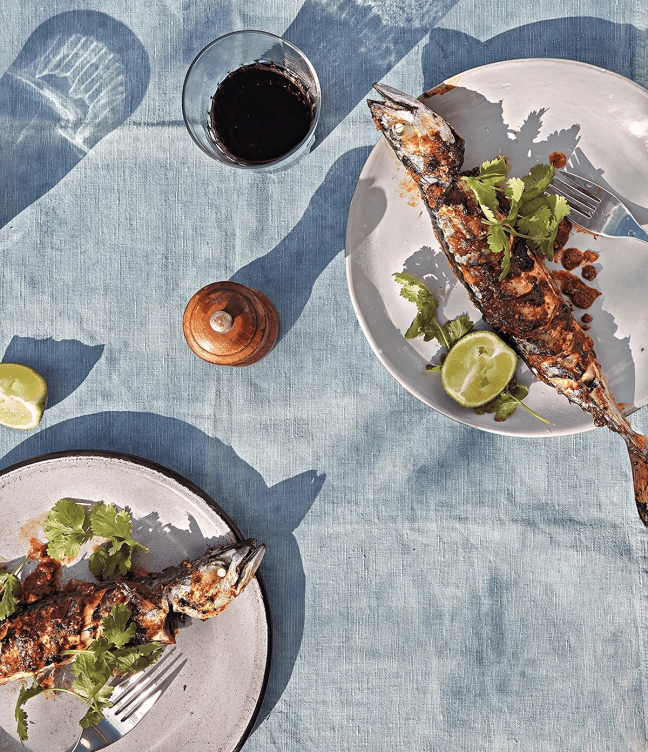5 of London’s best chefs on what to BBQ this season (other than steak)
From a mass of lamb shoulder to a platter of sea bream slickened with wild-garlic butter, here’s what to fire up in the coming months
The almost spiritual act of barbecuing is everywhere – at the asados in south America, braai in South Africa, with the Brazilian churrasco and Filipino lechón, and in the barrel-smokers in Austin, Texas.
It is an occasion to watch the magical properties of coal and fire transcend raw ingredients into dishes that soar – but with the ever-growing understanding of, and obsession with, food and restaurant culture here in the UK, a few links of supermarket-bought bangers, Portobello mushrooms and the low-hanging fruit that is a fillet steak just don’t seem to cut it any more.
Ahead of the balmier days to come, we’ve spoken to a handful of the capital’s most accomplished chefs to help bring some originality to your cookout.
Sanbei chicken-butts skewers, courtesy of Erchen Chang (co-founder and creative director at Bao)


Makes 4 skewers
Ingredients:
- 16 chicken butts
- A few sprigs of Thai basil, to garnish
For the sanbei sauce
- 1 tsp vegetable oil
- 1.5 tsp sesame oil
- 40g ginger, sliced
- 40g garlic, crushed
- 10g spring onion, roughly sliced
- 3g red chilli
- 30g rock sugar
- 75ml Shaoxing wine
- 45ml rice vinegar
- 2 tbsp dark soy sauce
- 3 tbsp light soy sauce
- 2 tbsp mirin
- 60g chicken stock or water
Method:
- Start by making the sanbei sauce – so, in a frying pan over a medium heat, cook the ginger for 5 minutes, until it reaches a light-gold colour, then add the garlic, spring onion and red chilli to the pan and continue to cook for a further 5 minutes. Add the rock sugar and let it dissolve completely.
- Then add the Shaoxing wine and rice vinegar, and stir to deglaze the pan. Add the remaining ingredients and bring to a boil. Once boiling, turn it down and let it simmer for 5 minutes.
- Remove from the heat and set aside to infuse for an hour.
- Once an hour has passed, put the chicken butts in a saucepan and cover in the sanbei sauce. Bring the saucepan to a boil then turn off the heat and cover. Let it poach in the residual heat for 20 minutes, then remove the butts and let them cool completely.
- Skewer 4 chicken butts on each wooden skewer, and repeat with the remaining butts. As a note, the soft bone in the butt is a delicacy, so we like to keep it in – it gives this fatty cut a little crunch (it’s like eating cartilages).
- Prepare your barbecue and grill the chicken butt skewer over high heat on a charcoal grill for a few minutes until nicely charred. Dip the skewer into the remaining sanbei sauce midway through cooking and grill further to get a nice char around the edges of the butt.
- Serve with thinly sliced Thai basil on top.
Coal-roasted leeks, walnut-and-sage tarator, and date brown butter, courtesy of Neil Campbell (head chef at Rovi)


Serves 4
Ingredients:
- Approx. 2 whole leeks
- Crispy sage, to garnish
- Leek skin (which will come once the leeks have cooked), to garnish
For the tarator
- 200g walnuts
- 50g garlic
- 130g muscat vinegar
- 120g walnut oil
- 400g olive oil (early harvest)
- 20g fresh sage, chopped
- 100g Greek yogurt
- 100g buttermilk
For the butter
- Salted butter
- Date molasses
- Lemon juice
Method:
- This recipe can be easily scaled up by just adding one more leek and 50g walnuts per portion. Also, you could use a gas burner and finish the leeks in an oven – but I really do recommend live fire, as cooking over coals and wood makes a big difference. Leeks can be cooked a day ahead if needed.
- First, have your coals and wood burning red-hot with no flame, and start by cooking the leeks, placing them on grill bars. Slowly grill and turn the leeks – we want the first few outer layers of the leeks to start turning black, which will create a shell and allow a slow steam-cook inside. To check when the leeks are completely cooked through, you should be able to squeeze them with your fingertips in the middle and not feel any crunch. When they have reached that point, remove them from grill and cover in cling film to steam for 30 mins or more.
- Then, carefully peel the leeks, saving a few of the outer, less burnt layers for garnishing (they will most probably need further drying in the oven). When peeled, cut the leeks in half, lengthways.
- For the tarator, roast the walnuts in an oven for 3 minutes at 180C. Then combine all ingredients, except the yogurt and buttermilk, in a food processor. Process until starting to become smooth, then finish with the dairy products and adjust the seasoning.
- For the burnt butter, place the diced cold butter in saucepan over medium heat, keeping a close eye on the colour and smell. When the butter starts to turn a golden colour and smell nutty, remove from heat and add lemon juice and then the date molasses.
- To finish the dish, place the lightly charred leeks cut side down, then add some crispy sage leaf (save some for garnish) and a pinch of salt. Pull leeks apart and toss in the date butter (save some for garnish). Spoon some of the tarator on to the plate, followed by leeks, and finish with the remaining crispy sage leaves and date butter, and some of the dried leeks skins for crunch.
Grilled pink bream with wild-garlic butter, courtesy of Nieves Barragán (chef director at Sabor)


Serves 6
Ingredients:
For the fish
- 3 whole breams (around 1kg each, and ask your fishmonger to scale, gut and butterfly them for you. If you can’t get pink or wild bream, you can use regular sea bream or sea bass instead)
- 100ml extra-virgin olive oil
- 8 garlic cloves, crushed
- 6 bay leaves, crushed
- 1/2 bunch of fresh thyme
- 1 lemon, juiced
- Sea salt
- Freshly ground black pepper
- Fish-grilling basket
For the wild-garlic butter
- 60g wild garlic leaves, stalks removed
- 125g unsalted butter, softened
- Sea salt
- Freshly ground black pepper
For the salad
- Crunchy leaves, such as Castelfranco, butterhead or radicchio
- 1/2 bunch of dill
- Extra-virgin olive oil
- Moscatel vinegar
- Sea salt
- Freshly ground black pepper
Method:
- This is really simple: the most important thing is getting the skin right (don’t even think about not eating the skin!). You want to cook it quickly, so it crisps and is juicy inside – if it cooks too slowly, the skin won’t become crispy.
- Blend all the ingredients for the wild-garlic butter together until smooth and green in colour. Using a spatula, if needed, tip out the mixture lengthways onto a sheet of cling film and make a cylinder about 15cm long. Fold one side of the cling film over the butter and begin to roll. Twist the ends to seal and set aside in the fridge.
- Get your barbecue going and make the marinade while it heats up. Combine the extra-virgin olive oil, crushed garlic, crushed bay leaves, lemon juice and salt and pepper in a small bowl and mix together. The thyme will be your brush, so place this in the marinade and set aside for later.
- Make sure your coals are nice and hot – they should be white with glowing-red embers.
- In a baking tray, massage the fish with plenty of olive oil, and season with salt and pepper – this will help it to get nice and crispy and keep it from sticking – before placing the fish skin-side down in your grilling baskets over the hot coals.
- When the skin is looking good (crispy, but not burnt) and the flesh of the fish is starting to change colour, it’s almost ready to turn. First, however, brush the white flesh of the fish with the marinade using the thyme brush and then flip.
- Take your wild-garlic butter out of the fridge and slice 6 rounds about half a centimetre thick. Place them onto the skin of each fillet of the bream and it will melt into a beautiful sauce as the fish finishes to cook.
- Break off the salad leaves, keeping them whole, and dress in a bowl with a drizzle of extra-virgin olive oil, a splash of moscatel vinegar, salt and pepper, and plenty of finely chopped dill.
Smoked lamb shoulder with charred hispi cabbage, courtesy of David Carter (chef and founder of Smokestak)


Serves 6
Ingredients:
For the lamb shoulder
- 2–2.5kg lamb shoulder, bone in
- 2 tbsp olive oil
- Salt
- Pepper
- 3 cloves of garlic
- 2 sprigs of rosemary leaves, roughly chopped
For the hispi cabbage
- 1 hispi cabbage
- 2 anchovies
- 2 cloves of garlic, finely chopped
Method:
- Create a marinade mixing olive oil, salt, pepper, garlic and rosemary. Place your lamb in a roasting tin and cover with the marinade, making sure to get into all the folds in the meat. Refrigerate for 24 hours.
- Remove lamb shoulder from fridge and leave to stand at room temperature for up to an hour while you heat the barbecue to 120C.
- When you’re ready, place the lamb on the grill in the tin, offset from the coals, and cook for 5-6 hours with the lid on, checking every few hours.
- Pierce the thickest part of the meat with a metal skewer and when there is just enough give, the shoulder is ready (it should be 85-90C).
- Take the lamb off the barbecue and wrap it in foil, leaving for 30 minutes to rest. Set aside the juice that is left in the tray, as you will use this for the hispi cabbage.
- While the lamb is resting, cut your cabbages in half from top to bottom through the root. Bring a large pan of salted water to the boil, and blanche the cabbage for 2–3 minutes until tender but still holding together. Allow to cool slightly. This step can also be done in advance and the hispi refrigerated.
- Brush the cut-side of cabbage liberally with some of the lamb fat left in your roasting tin and while your grill is still hot, place the cabbages cut side down and leave so they begin to char and caramelise. Flip the cabbages over and repeat on the other side until evenly charred.
- Meanwhile, in a separate pan, pour in 2 tablespoons of the lamb fat, chopped anchovies and garlic and cook for 2-3 minutes on a medium heat until aromatic. Pour atop the face of the cabbage. Serve alongside the lamb with some grilled flat breads and mint dressing on the side.
North African spiced mackerel, courtesy of Rick and Katie Toogood (co-founders of Prawn on the Lawn)

Extract credit to: Prawn on the Lawn: Fish and seafood to share by Rick and Katie Toogood (Pavilion Books). Image credit Steven Joyce.

Serves 4
Ingredients:
- 4 mackerel, gutted and cleaned
- Sea salt
- 1 tbsp coriander seeds
- 1 tbsp cumin seeds
- 4 cloves of garlic, peeled
- 2 tbsp paprika
- 1 preserved lemon, plus a splash of the liquor from the jar
- 1 small bunch of parsley, roughly chopped
- 1 small bunch of coriander, roughly chopped, with a few leaves reserved for garnish
- 1 tsp tomato purée
- 40ml olive oil
- Lime wedges, to serve
Method:
- Bring a barbecue up to temperature.
- Using a sharp knife, score the mackerel along both sides of the body and season with a little salt.
- Heat a heavy-based frying pan (skillet) over a medium heat and toast the coriander and cumin seeds, for about 1 minute, until fragrant, then transfer to a spice grinder or pestle and mortar and crush. Add the crushed spices to a food processor, along with the garlic, paprika, preserved lemon, a splash of the lemon-preserving liquor, parsley, chopped coriander, tomato purée and olive oil, and blend for 1 minute.
- Rub the spice paste over the mackerel and into the scored flesh and cook over the hot barbecue for about 4 minutes on each side.
- Transfer the fish to a serving plate, and garnish with the lime wedges and reserved coriander leaves.
Prefer to let someone else do the cooking? Here are the London restaurants where you should blow your bonus…
Become a Gentleman’s Journal member. Find out more here.

Become a Gentleman’s Journal Member?
Like the Gentleman’s Journal? Why not join the Clubhouse, a special kind of private club where members receive offers and experiences from hand-picked, premium brands. You will also receive invites to exclusive events, the quarterly print magazine delivered directly to your door and your own membership card.
Further reading

Restaurant review: with ABC Kitchens, Jean-Georges Vongerichten produces yet another multi-layered venture

Defined by power and body, this is why the Penfolds Bin 707 is analogous to a jumbo jet
